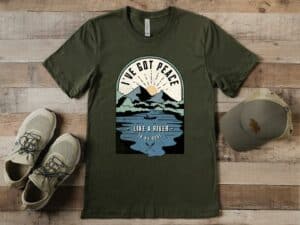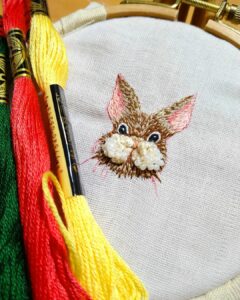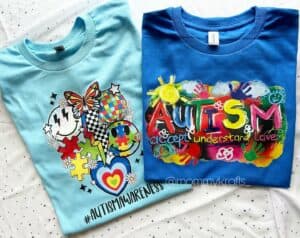DTF printing and embroidery are two common techniques for personalizing garments. Direct to Film printing, often known as DTF printing, is a digital printing technology that transfers graphics from a film to a garment using a heat transfer process. Embroidery involves using a needle and thread to stitch patterns onto clothing. But, DTF Printing vs Embroidery which is better for your business? Both techniques have benefits and disadvantages of their own. DTF printing offers a broad spectrum of colors and accurate details, while embroidery adds texture and durability. We’ll examine both strategies and analyze their benefits and downsides to help you choose the best one.

What is the difference between printing DTF and embroidery?
| Parameter | DTF Printing | Embroidery |
|---|---|---|
| Design Capabilities | Wide color range, precise detailing, good for photographic or gradient images. | Limited color range, limited ability to produce fine details, good for adding texture to designs. |
| Fabric Compatibility | Works on a range of fabrics including cotton, polyester, and blends. | Works on most fabrics but may be limited for certain types like stretchy or very thin materials. |
| Cost | Generally less expensive than embroidery. | Generally more expensive than DTF printing. |
| Turnaround Time | Faster than embroidery due to automated process. | Slower than DTF printing due to manual labor. |
| Durability | May fade or wear over time with use and washing. | Generally more durable and longer-lasting due to physical stitching into fabric. |
| Final Appearance | Smooth and even finish. | Adds texture to designs and may have a raised or 3D appearance. |
DTF Printing
Direct to film (DTF) printing uses a heat press to transfer patterns from a film to a garment. The design is first printed using a specialist printer onto a unique kind of transfer film. The transfer film is then placed onto the garment and pressed using a heat press to transfer the design onto the garment.

Benefits of DTF Printing:
- Broad Color Spectrum: DTF printing supports a variety of colors, including vivid and strong colors, gradients, and shading, which makes it a great choice for complicated and detailed designs.
- Fine Detailing: DTF printing provides precise detailing, making it possible to print small lines and complex patterns with extreme precision and clarity. As a result, even minute features and text can be printed with clarity on the clothing.
- High-Quality Print: DTF printing creates prints of exceptional quality and resolution, making it a great choice for creating designs that seem professional.
DTF printing limitations:
- Restricted selection of textiles: Synthetic fabrics like polyester and poly-cotton blends perform best for DTF printing. With natural fibers like cotton, silk, and wool, it may not work properly.
- Expensive Equipment: DTF printing requires specialized equipment such as a DTF printer and a heat press, which are expensive and may not be cost-effective for small-scale production.
- Time-Consuming: As the transfer film must be printed, cut, and applied to the garment, DTF printing might increase manufacturing time.
- DTF printers need regular maintenance.
Embroidery
Embroidery involves putting patterns into garments using needle and thread. The procedure starts with digitizing the design and loading it onto an embroidery machine in a machine-readable format. The garment is then stitched with the pattern utilizing a number of stitching methods by the machine.

Benefits of embroidery:
- Durability: Embroidered creates long-lasting, durable patterns, making it a great choice for workplace, athletic uniforms, and other high-use clothing.
- Texture: Embroidery gives patterns a three-dimensional appearance and feel that other printing methods cannot.
- Embroidery is versatile because we can use it on a wide range of textiles, including cotton, denim, leather, and even mesh. This makes it a fantastic choice for a variety of applications.
What are the disadvantages of embroidery?
- Color Restrictions: Since each color takes a different spool of thread and might raise manufacturing costs, embroidery can only reproduce a lesser spectrum of colors than DTF printing.
- Embroidery can’t handle tiny text or elaborate patterns. This is because the act of stitching may cause patterns to become distorted or blurry.
- Production Time: Embroidery might take a while, particularly for complex designs with various colors. Production time and expenses may rise as a result of the setup, digitization, and stitching processes.
Comparison of DTF Printing and Embroidery
1. Cost
The price of DTF printing and embroidery will vary according on the order’s design, size, and quantity. As DTF printing doesn’t need the use of several spools of thread like embroidery, it may be more cost-effective for patterns with a high degree of detail and various colors.
DTF printing, however, might be more costly for small orders or designs that need for a lot of white ink. Nevertheless, for bigger quantities or patterns that just need a few colors, embroidery is more economical. Does that mean embroidery is cheaper than DTF printing? Yes, it is but the price can go up for designs with small text or a lot of small details.
2. Turnaround Time
Depending on the size of the order, the difficulty of the design, and the manufacturing schedule, the turnaround time for DTF printing and embroidery might vary. Specialized software and equipment make DTF printing fast.
DTF printing is a popular option for urgent orders since it can generate high-quality prints in only a few minutes. On the other side, embroidery might take longer to create since each design has to be set up for the embroidery machine, digitized, and stitched.
Depending on the size of the order and the complexity of the design, the turnaround time for embroidery might be anything from a few days and a few weeks.
3. Design Capabilities
DTF Printing:
- High degree of detail and accuracy: DTF printing is perfect for intricate designs and graphics since it can make designs with tiny lines and small text.
- Full-color range: DTF printing can create artwork with a variety of colors, enabling more imaginative and eye-catching designs.
- Photographic and gradient pictures can be reproduced by DTF printing with excellent precision and resolution, making it ideal for generating images with a variety of tones and colors.
Embroidery:
- Texture in three dimensions: Embroidery gives pattern texture, giving them a three-dimensional, tactile appearance.
- Durability: Designs created by embroidery stay for a long time and can resist repeated washing and wearing.
- Embroidery has a certain visual appeal that may give the design a feeling of beauty and sophistication.
4. Durability

DTF Printing::
- It resists fading, peeling, and cracking on polyester and poly-cotton blends.
- DTF printing may not be as durable on dark or thick textiles like denim or canvas due to ink adhesion issues.
Does embroidery last longer?
- Embroidered patterns can resist repeated washing and wearing on cotton, polyester, denim, and canvas.
- These patterns last longer, thanks to high-quality threads and workmanship. Years may pass before a design fades or degrades.
Which is better, DTF print or embroidery?
Designs with many colors, fine details, and photographic or gradient pictures work best with DTF printing. For huge numbers of patterns, it is also quicker and less expensive than embroidery, and you can apply it to a range of textiles. Nevertheless, it is not as durable as embroidery and can only be used on certain fabrics.
Designs that call for texture, durability, and a distinctive visual appeal are better suited for embroidery. We can use it on a variety of materials and is very strong and long-lasting. It is more costly and time-consuming than DTF printing and may not work for designs with many colors or fine details.
DTF printing or embroidery depends on project requirements such design intricacy, fabric type, manufacturing timeline, and budget. A professional printing or embroidery service provider may be able to advise you on which approach is most appropriate for your requirements.
Is embroidery cheaper than DTF printing?
Often, embroidery is more costly than DTF printing owing to the time and work necessary to make each design. In order to create a tangible needle-and-thread pattern during embroidery, you need specific tools and trained personnel. The amount of thread colors in the design affects embroidery cost since each color needs a distinct stitching technique.
DTF printing, on the other hand, utilizes digital printing technology in a more automated manner to print patterns directly into textiles. It is typically quicker and less labor-intensive than embroidery, and it can print patterns with a broad spectrum of colors and fine features.
Generally, embroidery is more costly than DTF printing, but it also has several advantages, including texture and durability, that may make it more suited for some applications. In the end, the price of either approach will rely on the precise needs of the project and should be assessed on an individual basis.
Does embroidery last longer?
Embroidery lasts longer than DTF printing. In embroidery, intricate motifs are stitched into textiles using premium threads and sophisticated machinery. Even with frequent washing and usage, the embroidery technique generates a physical pattern that is woven into the fabric so it’s less susceptible to discoloration or wear away over time.

DTF printing, on either side, uses ink to apply graphics directly to textiles utilizing digital printing technology. DTF printing may generate high-quality graphics with a broad variety of colors and details. But, the printed pattern is not woven into the fabric and may fade or wear away with continuous usage and washing.
Nevertheless, the lifespan of embroidery and DTF printing depends on the fabric, garment care, and manufacturing materials and equipment. You should determine the ideal printing alternative for your unique requirements in consultation with a professional printing or embroidery service provider, who can also make sure that the completed item lives up to your standards for quality and longevity.
Why is embroidery declining?
A classic kind of handicraft, embroidery includes using a needle and thread to decorate materials. While embroidery has long been a significant form of expression and part of our cultural legacy, it is now experiencing a loss in popularity for a number of reasons.
First off, the popularity of quick fashion has lowered the need for handcrafted, labor-intensive methods like embroidery. Customers are searching more and more for inexpensive, mass-produced clothes, which sometimes lacks the fine artistry and delicate details of traditional needlework.
Moreover, producing embroidered patterns is now simpler and quicker because to the advent of machine embroidery. Due to this, there is less need for handcrafted embroidery, and the technique’ expertise and workmanship have become less valued.
Besides these reasons, we can say that the fall in embroidery is due to the younger generation’s lack of interest in ancient crafts and abilities. Less young people are interested in learning and practicing traditional crafts like embroidery in the digital era, when technology and fast-paced lives rule.
People feel discouraged from taking up embroidery as a pastime or a career. This is because the materials and time needed to accomplish an embroidered job might be too costly.
Ultimately, a mix of economic, societal, and cultural issues are the top reasons behind the fall of embroidery. A devoted group of needlework lovers still values and continues to perform this age-old skill despite this decline. If we look at the data, Dataintelo says the global embroidery market size will grow from $1.6B to $2.2B, at a CAGR of 3.3% by 2030.
Conclusion | Embroidery vs Digital printing
In conclusion, embroidery and DTF printing both have benefits and disadvantages. Although embroidery adds durability and texture, DTF printing delivers fine details and a larger color palette. The particular requirements of your project will ultimately determine which option you should use. You may decide which approach is ideal for your requirements by taking into account aspects like cost, design skills, and turnaround time.
FAQs
DTF printing is a digital printing process that use ink to apply graphics directly to textiles, hence producing high-quality and intricate designs.
Using sophisticated tools and premium threads, embroidery involves stitching patterns onto textiles to create a tangible design that is woven into the cloth.
DTF printing, which can create accurate and detailed pictures with a broad variety of colors, is often more suited for generating fine details in designs.
As embroidery gives a 3D look, it’s great for adding texture to patterns.
Embroidery lasts longer than DTF printing because the stitching is woven into the cloth.
DTF printing is cheaper than embroidery since it is mechanized and needs less manpower.
DTF printing works on cotton, polyester, and mixes. Nevertheless, it may not be ideal for particularly thin or elastic textiles.
Embroidery can generate complicated patterns, but it may lack color and precise details.
DTF printing is quicker than embroidery because it uses automated procedures and less hand work.
Yes, it is possible to mix DTF printing and embroidery in one design to get a distinctive and eye-catching result.

Ashley Wang is a skilled sales manager with knowledge in DTF printing. She presently works for ShenLan Digital, a reputable DTF printer maker. Ashley is the best person to offer advice on selecting the most suitable DTF printer because she has tested a lot of them. She launched DTFPrinterSchool to educate individuals and organizations about DTF printing technology, providing her expertise and observations on the most recent advancements in the sector. Ashley is an invaluable resource for businesses and individuals wishing to invest in DTF printing technology because of her expertise and experience in the industry.
